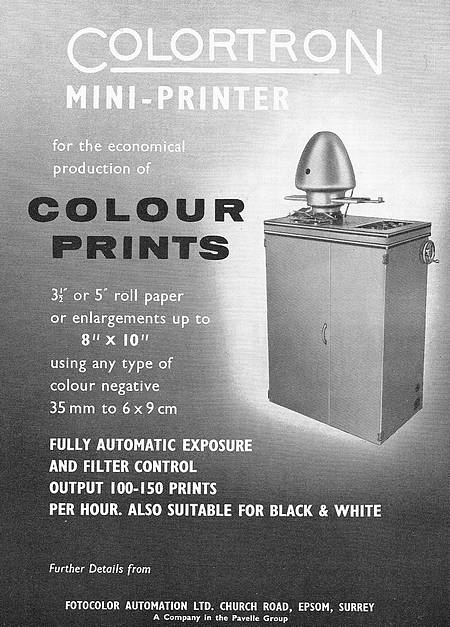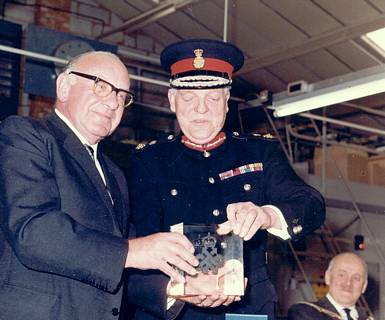| Dr. Kurt JACOBSON |
|
|
|
|
|
The following text is taken from a July 1985 document produced by Durst (UK) Ltd. It has been made available to me (November 2009) by Dr Jacobson's son, Dr Ralph Jacobson, Emeritus Professor of Imaging Science at the University of Westminster. Also, Chief Editor of The Imaging Science Journal published by Maney for The Royal Photographic Society. Dr. KURT JACOBSON was born in 1906 in Berlin. He attended Charlottenburg Technical University and Heidelburg University where he was awarded a Doctorate in 1930. Aged 24 he founded the Photographic Industry Laboratory in Berlin. He became editor of 'Die Photographische Industrie', the leading German industry magazine, chairman of the German Photographic Society and a member of the German Photographic Standards Committee, a research and consulting organisation used by many of the top photographic manufacturers, both in Europe and the United States. He was one of the world's leading authorities on photography and between 1922 and 1965 was responsible for around 30 major publications in journals, mainly in the field of emulsion chemistry and colour technology. |
||
|
He wrote 6 books including, the best known being 'ENLARGING' published in 1939 which now (1985) has gone through 22 editions, 'DEVELOPING' published in 1940 now (1985) in its 23rd edition and 'IMAGING SYSTEMS' written in collaboration with his son Dr. Ralph Jacobson, who also worked for his father's company and is now (1985) Senior Lecturer in Photographic Science and Technology at the Polytechnic of Central London. In 1939, Dr Kurt Jacobson emigrated to England and lived in London. When his operation there was bombed, he moved to Epsom and became associated with Dr.G.N White who operated the Goodwin White Chemical Research Laboratory in Epsom, which provided a consultancy service to the photographic industry, similar to that run by Dr. Jacobson in Germany. In addition, the partnership produced specialised organic chemicals for photographic manufacturers in the UK and abroad and was the first to provide organic restrainers and anti-foggants during the Second World War. Immediately after the war,
Dr. Jacobson set up a motion picture film processing laboratory
in Redhill to process "two colour" prints of American
feature films for the film industry. With the rapid decline of
such processes in the early 1950s in favour of "three colour"
negative-positive systems, Dr. Jacobson decided to enter this
field with financial help from Associated British-Pathe. This
work resulted in the production and marketing of a colour negative
film and a colour paper for amateur use under the name of Pakolor,
in 1953. At this time there was no other British manufacturer
of these products and this was seen as an important development
in the industry. |
|||
 |
Having resolved the difficult problem of manufacturing colour materials Dr. Jacobson and Dr. White turned their attention to the use of their products. The company started a (colour) developing and printing (D&P) service which proved very popular, but their use of converted black and white equipment was slow, wasteful, and unreliable, and so the volume of work very quickly overwhelmed them. With mail bags full of films remaining unopened for weeks, the partnership was forced into designing the necessary (colour developing and printing) machines for themselves. They first made a paper processor which relieved them of the arduous task of processing the finished print, but the task of acquiring the correct (colour negative) filtration and exposure, and then printing each negative frame, led them to design a 'grader' to make the necessary assessment and an enprint enlarger to make the exposure. These steps improved the work flow through the laboratory considerably and with the increasing widespread popularity of the colour negative-positive process, the machines were in demand by other manufacturers and laboratories and so the company started the manufacture of Pakolor equipment. Improvements in the design of the machines increased the speed and quality of the prints produced by them and they were also adapted to meet the specific needs of the users. As the sales of the printers and processors outgrew that of film and paper, a new company was formed called Fotocolor Automation Limited and the equipment was sold under the trade name of Colortron. A September 1965 advert for the Colotron '99' colour enlarger can be seen alongside. By the mid-1960's Dr. Jacobson's range of equipment was far ahead of the competition in that it provided the smaller D&P colour laboratories for both amateur and professional with low cost equipment exactly tailored to their needs and thereby enabling them to compete in a market that would otherwise have been dominated by the larger concerns that could afford to equip with other, more expensive, machines (see the Kodak S1, here) |
 |
An excellent export market also opened up, with two of the principal customers being Japan and the USA. This success resulted in the company receiving the "Queen's Award to Industry" in 1970 (see picture, top of page). During this period further
capital had been put into the company by Leo and Sy (Simon) Pavelle who had previously owned Pavelle
Color in New York, the largest independent laboratory in the
USA. This permitted the expansion of the company and the move
to new factory premises on the Longmead Industrial Estate at
Epsom when the company name changed to Pavelle Ltd. The company which was founded in the early 1950's in a few sheds in Church Road, Epsom, moved to a new factory with 10,000sq.ft (930m2) of floor area on the Longmead Industrial Estate on the other side of Epsom in 1965. This building was greatly extended in 1967, almost trebling the original floor area to 29,000sq.ft (2,700m2). In 1969 a second factory of 13,000sq.ft (1,200m2) was leased and in 1980 the present (1985) production factory was built, giving a total floor area of just over 71,000 sq.ft (6,600m2). Over this period, the staff increased from 2 to 260 and products were sold to 125 countries. Dr. Jacobson retired as Chairman of the Board in 1972. He died in 1983 and is remembered as an inventive and energetic researcher. He was a highly regarded scientist who played an important part in the development of the photographic industry throughout the world. |
|
The Colortron Mini-Printer advertisement, above, has been sent to me by Paul Godfrey. Paul Godfery comments: "...I worked for J.Barker & Sons who had bought out C.A.Chadwick Limited a photofinishing works based in Great Yarmouth. Chadwicks had mainly Kodak colour equipment but had purchased a Colortron Mini-Printer to do enlargements. These printers were very low in cost and covered a wide range of negative sizes, 6x9cm – 35mm and print sizes 3½", 5" & 8" wide. The original Mini-Printer had a tungsten lamp and condenser illumination. It was a three exposure additive printer of a very simple but very effective design. It only needed a single photomultiplier cell measuring the light that came through the lens. As you can see it was an enlarger in a box but this is too simple a description for a printer that revolutionised professional wedding and social photography. In the mid 1970s I worked for the Lowestoft photographer Peter Jenkins. The Jenkins were a photographic dynasty and Peter’s grandfather Harry started the business that was taken over by Peter’s father Ford Jenkins. Peter had a Durst Mini-Printer that was a vast improvement over the earlier Colortron one". Michael Talbert adds "The Durst Colortron cost £425 in 1961/2. This was the Net Professional price as it says in the advert for the machine in the B.J. Annual for 1963. I take it from the advert that it could handle 3½ and 5 inch paper in rolls (Kodak UK were making these sizes in Ektacolor paper in 1961) so I presume the largest print that could be made on roll paper was 5 x 7 inches. I get the impression from the advert that anything larger, up to 8 x 10 inch, had to be printed onto sheets of paper. |
|
|
Michael Talbert used two Durst printers for about three years while working at C.P.L. in the 1970s, the Durst Mini-Printer and the Durst Maxi-Printer. The Mini-Printer could print up to 8 inch x 10 inch prints on 8 inch wide roll paper. The Maxi-Printer was much larger and could print up to 12 inch x 15 inch on 12 inch wide roll paper. The largest negatives the printers could handle was 5 x 4 inch. Looking back, I don’t think the integration was set up very well, or the negatives didn't integrate as well as on the Gretag printer. I used the printers in the same way as a colour enlarger, making about three or four test strips from each negative. There were three knobs for filtering: yellow, magenta, and cyan. If the print came out too blue you dialled up the yellow knob, the opposite to when filtering with a colour head enlarger. Also the machines compensated for extra filter density automatically, unlike an enlarger, where e.g. if you dial increased magenta, you have to increase the exposure. Their were two sets of adjustable dials on the Durst Mini-Printer, one for setting up the integration and the other for correcting colour balance. The dials were numbered 0 to 5, and if you needed more than 5 correction, you could add more by adjusting the set up dials. It was extremely rare to need more than 5 correction. Dial and button seemed to mean the same thing! C.P.L. also used Durst HS 78 printers which, I believe, took up to 8 inch wide roll paper for a maximum of 8 x 10 inch prints. The bulk of the small machine prints was done on these printers, especially from roll film negatives. The largest roll film negative format these machines could handle was 6 x 9 cms. They could not print from sheet film negatives, 5 x 4 inches and upwards. There is a picture of a Durst HS 75 printer in J. Coote’s book, “Photofinishing”. It looks older than the HS 78 printers that I remember but very similar. All printers (except the Gretag) had a large density button which may have been calibrated in ½ stops of density. The colour buttons were moved in quarters, with a quarter being a just discernable change in colour, about 2½ cc Kodak colour printing filter, or about 4 density on an Agfa colour head. It is worth pointing out that when all the colour correcting buttons were set at 0, this did’nt equal the filtration of a colour head with all three filters set at 0, i.e. no filtration. The 0 setting meant that the machine was making the print at the integration setting only, and the colour correcting buttons were there to correct the colour balance from the integrated test strip. If the print came out green, you dialled up magenta, or if the print came out magenta, you dialled down green. 0 was in the middle of the dial/button, 1 to 5 up for magenta, 1 to 5 down for green, and similar with the yellow/blue and cyan/red buttons. The density button for a first test was usually set it to the middle of the range and the colour correcting buttons were all set at 0. The integration wasn't that good but it helped when exposing a first test strip. The Durst Mini and Maxi-Printers were both “enlarger” printers, where you could set any size between 5 x 5 inch on the Mini using 5 inch wide roll paper to 12 x 15 inch on the Maxi using 12 inch wide roll paper. The filtrations were written: ½Y, 1¼C, ¾G, 32D. I still use this method of writing filtrations when printing in Photoshop. |
|
|
|
|
|
|
|
||
